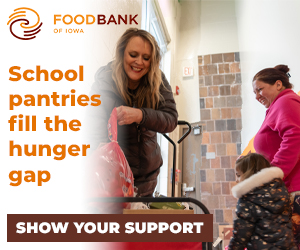Patty Sneddon-Kisting leads the Urbandale Food Pantry, which recently moved to a bigger site. (Photo: Steve Dinnen)
By Steve Dinnen
The U.S. Department of Agriculture believes a family of four can feed themselves for a month for as little as $567. Multiply that by 2,000 — the number of families that the Urbandale Food Pantry serves every month — and you can see why the nonprofit has launched a campaign to raise $3.5 million.
This money isn’t for food. It’s for the new headquarters on Douglas Avenue, which is twice as big as the old place and includes dedicated areas for receiving and warehousing food. No longer will clients have to wait on the sidewalk to get into the former headquarters, which is just two blocks away.
The Urbandale Food Pantry first opened its doors in 2008, when it served only Urbandale and Windsor Heights. Business took off when it went “border free” in 2016 and started serving people no matter where they lived. Patty Sneddon-Kisting, the executive director, said they now serve clients from 76 ZIP codes.
“Food insecurity is in every community,” she said.
The pandemic and resulting disruptions of the economy and society prompted a surge in use. Despite the economy’s recovery, the demand for donated food remains as strong as ever. The pantry’s old facility just “wasn’t sustainable,” Sneddon-Kisting said.
So her team found a new building, bought it, reconfigured it to fit their needs and recently opened its doors for a bigger future. The capital campaign has earmarked $470,000 for the building’s purchase, $2.6 million for construction, and $500,000 to support increased operational expenses that have come with the expansion.
Fundraising is about two-thirds complete. Companies, including many with ties to the food industry, have kicked in some money, and personal donations have covered the rest. One of the largest contributions came from an anonymous donor who volunteers on-site.
In all, more than 200 volunteers handle most of the day-to-day work. They stock shelves, unload delivery trucks and drive around town to round up food donated by grocery stores, restaurants and convenience stores. Most of this is “rescue food,” which has been prepared but not sold by the business. Iowa’s Good Samaritan law for perishable foodstuffs shields donors from any liability. By paying close attention and acting quickly, pantry volunteers gather 670,000 pounds of rescue food every year.
Clients can visit either of the pantry’s two sides. The daily side offers rescue food, which varies on what the volunteers round up. The monthly side has milk, eggs and meat, along with diapers, formula and personal care items.
All told, the pantry distributes 1.8 million pounds of food a year. That’s a lot of meals. And that’s why it takes $3.5 million to put that meat on the table.










